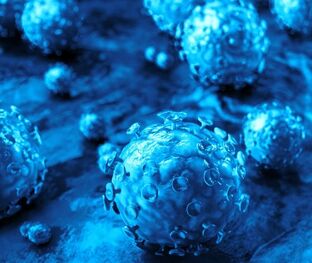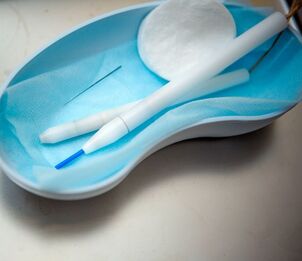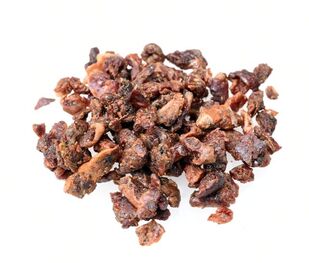Penile warts are small growths that are located in the foreskin, frenulum, glans or shaft of the penis. They are also called genital warts. It provokes the pathology of papillomavirus of certain strains, which are prone to recurrent manifestations and are never completely removed from the body.
Causes of penis warts in men

Warts are viral growth caused by the human papillomavirus. HPV is a large group of pathogenic microorganisms. About 100 strains of this pathogen have been studied. These viruses are also divided into different categories according to the level of oncogenicity.
According to rough estimates, approx. 90% of the world's population is infected with some form of papillomavirus. Pathogens live very little in the external environment and die quickly. Most often transmitted through sexual contact, less frequently in everyday life or from mother to child. Antivirals are located in the surface layer of the mucous membranes and epidermis.
With regard to penile warts in men causes strains 6 and 11. These viruses are responsible for genital warts. These are conditionally non-oncogenic types that can very rarely cause malignancy in neoplasms.
In order for the virus to enter the body, direct contact between the infected skin or mucous membrane and healthy skin is necessary. This usually happens during unprotected sex. The risk of infection increases if there is microtrauma on the surface of the body - wear, cracks, scratches. The virus penetrates these lesions especially easily and quickly.
HPV multiplication occurs in the deep layers of the skin inside the cells of the human epidermis. As the disease progresses, epithelial cells move upward by viral means. So papillomavirus reaches the surface of the skin and causes a rapid chaotic growth of epidermal cells. This leads to the formation of warts on the penis.
A distinctive feature of papillomavirus is that it can remain dormant for a long time in the deep layers of the dermis. Various factors can provoke its progress. For example, weakening of the immune system, hypothermia, intake of antibiotics, stress, overexertion, poor nutrition, vitamin deficiency, hormonal imbalance, etc.
However, even when the virus is latent, a person is potentially dangerous in terms of transmitting HPV to partners. Once we know the causes of warts on the penis, we can conclude that these formations can occur both in young people who have recently started having sex and in the elderly.
Symptoms and types of warts on the penis

In most male patients, warts on the penis usually do not manifest themselves in any way. Most often, the places that are exposed to damage during intercourse are formed. Therefore, neoplasms can be found on the head, frenulum, foreskin. Less commonly, they appear on the trunk of the penis and scrotum, the testicles.
Warts on the penis usually look like small growths of a pink, beige, whitish shade, 2-30 mm in size. They can be simple or strike out in groups and form neoplasms similar to a rooster comb.
In the phase of active growth, when the immune system fails, warts on the penis can cause itching and burning in the affected area. Also, sometimes neoplasms are palpable during intercourse. In normal condition, these growths are painless and do not cause any discomfort.
Often, condyloma does not affect a limited area of the genitals, but large areas. Therefore, warts often spread on the head of the penis gradually throughout the groin area and affect the anus.
Types of warts on the penis depend on the virus strain that infects the man, as well as on their location.
Let's consider their main types:
- In the foreskin, the neoplasms are in tubercles with a lighter shade than the skin. Sometimes they have a thin leg. Initially, individual warts appear, over time, groups of genital warts may form.
- On the frenum, warts look like small whitish nodules with a chaotic arrangement.
- Warts on the glans penis resemble pink finger-like growths. Usually they form clusters similar to the inflorescence of broccoli.
- Giant Buschke-Levenschein tumors can sometimes form on the shaft of the penis. They are several warts that have grown together. This is a rare but dangerous pathology that is fraught with malignant transformation as the cells in the neoplasm are prone to rapid mutation.
If there are suspicious growths on the penis, a man should consult a specialist immediately. The urologist examines and interviews the patient. In addition to the penis, the urologist must examine the scrotum, perianal area and groin. Usually, a visual examination is sufficient to make a diagnosis. In some cases, the doctor may refer the man for further tests.
To identify the strain of the pathogen and the risk of oncogenicity, the patient must donate blood for a PCR test. If the frenum is damaged, a meatoscopy procedure may also be necessary to determine the presence of warts in the urethra.
It should be remembered that warts on the head of the penis and scrotum may look like tumors of other species. For example, papulosis in the second stage of syphilis is also characterized by the appearance of small neoplasms. To rule out other sexually transmitted diseases, it is necessary to be tested for common sexually transmitted infections - syphilis, HIV, chlamydia, trichomoniasis, etc.
Danger of warts on the penis in men

Originally, warts on the penis represent an aesthetic defect rather than a serious pathology that threatens a man's health. However, this does not mean that they do not need to be treated. If you let the disease go its course, it can lead to more serious problems in the future.
The danger of these neoplasms is as follows:
- Development of phimosis.In this condition, the foreskin melts with the head of the penis. Because of this, problems with normal sperm discharge can occur, pathogens accumulate in the space under the foreskin, and inflammatory processes can occur.
- Inflammation of the head, the trunk of the penis.This pathology is a complication of the above condition when bacteria penetrate under the foreskin and spread further.
- Genital erosion.They often develop as a result of systematic trauma to the warts on the penis. This happens during intercourse, shaving, wearing tight underwear.
- Degeneration of neoplasms in cancerous tumors.This is rare, but there is a potential danger, especially if the warts on the penis are often damaged.
Also, do not forget that active neoplasms are dangerous for partner infection. Moreover, even condoms are not always able to protect a person from infection.
Treatment methods for penile warts
Since the appearance of warts on the penis is directly related to a general decrease in immunity, the treatment of this pathology must be complex and combined. Basically, in relation to neoplasms, different methods of destruction are used. To increase immunity and suppress the virus, drugs are used.
Ways to remove warts on the penis

Instrumental and chemical methods are used to remove warts on the penis. It is worth remembering that these growths are in themselves extremely rare and therefore should be removed if a man seeks to minimize the risk of complications.
There are several ways to get rid of warts on the penis:
- Laser destruction.The laser beam evaporates liquid from the accumulation, it dries up, becomes covered with a crust and falls off after a few days. As a rule, there are no traces at the treatment site. The procedure is painless, rarely leads to relapses and complications.
- Removing Cryo.Liquid nitrogen having a low temperature is applied to the neoplasm point by point, leading to freezing and subsequent death. After treatment, a crust forms at the site of build-up, which also disappears after a few days along with the rest of the formation.
- Radiosurgical removal.Neoplasms are affected by radio waves that destroy the growth tissue. This is one of the most accurate, effective and safe ways to remove warts on the penis. After removing radio waves, there are no marks left on the skin.
- Electrocoagulation.At a certain frequency, a current is applied to the electrode, which destroys the formation. This procedure for removing warts on the penis can lead to burns and subsequently to scarring. Therefore, it is prescribed with caution.
- Surgical excision.If the wart on the penis is too large, the technique of cutting it with a scalpel can be used in extreme cases. However, they rarely resort to such surgery as there is a risk of severe bleeding and spread of infection. In addition, a complete circular excision of the foreskin is indicated for extensive wart lesions.
Your doctor may also prescribe the removal of chemicals. The procedure is performed using cauterizing medication.
Medicines for penile wartsBefore curing warts on the penis using chemicals, it is imperative to consult a doctor as these remedies have a number of contraindications and their incorrect use threatens complications.
To eliminate the risk of recurrence of warts on the head of the penis or other parts of the genitals, it is necessary to take care of increased immunity as well as suppress the virus in the body. Different groups of drugs are used for this purpose - antiviral and immunomodulatory.
Also with HPV, it is important to stimulate the work of the body's defenses, which for some reason are in a depressed state. Immunity will actively fight the pathogen and reduce the risk of warts reappearing on the penis.
It should be understood that drug treatment is not able to completely solve the problem of warts in the penis. To get rid of them it is necessary to resort to instrumental techniques to eliminate growth.
Folk medicine for warts in the penis

If you are considering how to treat penile warts, help can be found in traditional medicine. Remember, however, that you should only use these techniques after consultation with your doctor. Self-medication can at least be in vain and in the worst case lead to serious complications.
The following tools are popular:
- Tea tree oil.Powerful herbal medicine that helps suppress pathogen activity. It is necessary to rub the substance into the warts on the head of the penis several times a day every day until the growth is completely eliminated.
- Propolis.Another natural medicine that helps fight viruses. To remove warts on the penis, apply the drug on the growth before going to bed every day for 10-14 days.
- Egg white.It is necessary to take crude protein and lubricate the neoplasm with it several times a day.
- Bordeddike.Acid corrodes pathological tissue, so be careful not to damage nearby healthy areas. You need to lubricate gently and punctually.
- Rowan juice.The acidic substance contains phytoncides that have antiviral effects. Apply freshly squeezed liquid warts to the penis daily.
The above recipes are only suitable if you know for sure that you are dealing with HPV and the neoplasm is small and simple. Otherwise you can not do without special therapy.
Prevention of warts on the penis

Timely treatment of penile warts significantly reduces the risk of complications and recurrence in the future. It is also a way to avoid transmitting the virus to your sexual partner.
One of the most effective methods of prevention is vaccination with special polyvalent vaccinations. They work against pathogens of type 6, 11, 16 and 18 - exactly the ones that cause genital warts.
Although a condom cannot guarantee 100% protection against HPV, it should be used as it reduces the risk of infection by 20-30%. Among them, it protects against other sexually transmitted infections.
If a man is already infected with HPV, it is necessary to follow the rules of a healthy lifestyle to reduce the risk of warts on the penis. It is important in a timely manner to suppress exacerbations of chronic disorders, eat right, exercise physically and maintain immunity in a "battle-ready" state.
If you are considering how to remove warts on your penis, contact a doctor immediately. Self-medication in this case can only harm. The procedure for removing neoplasms is quick and almost painless. In addition, it is important to strengthen the body's protective functions to avoid relapse in the future.














































































